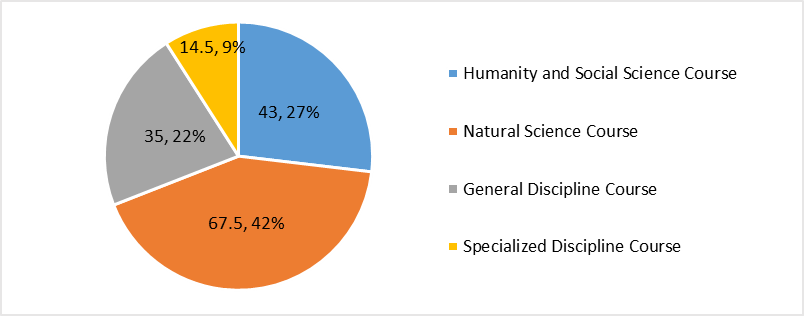The SEEE grants a bachelor's degree for EE for the four-year undergraduate program. 160 credits are required to complete the program. The average credit per semester is about 20. Students take four hours of lectures per workday, plus practice training courses implemented in the summer vacation. The distribution of credits is illustrated in Figure 1.

Fig. 1 Credits distribution in the undergraduate curriculum
Figure 2 presents the roadmap of the required courses in the undergraduate program (not including humanity and social science courses).
Humanity and social science courses include 32 credits in history, culture, philosophy, and arts, 4 credits in physical education and 7 credits in foreign languages.
Natural science courses include math, physics, chemistry. There are 21 required math courses, covering calculus, algebra, numeral analysis and statistics. The 14-credit physics courses cover general physics, mechanics, electromagnetics, and related experimental courses.
The 43 credits of general engineering courses provide the foundation for further study in the field of EE. The core courses include electrical circuits, analog and digital electronics, signals and systems, computer architecture and programming skills.
The primary natural science and general engineering course are given in the first two and the first half of the third year, providing sufficient time for students to decide general discipline courses and specialized courses.
Two sets of specialized discipline courses, i.e., electrical device course group and power system course group, form the core of the undergraduate program. The electrical device course group consists of five courses, including Fundamental of Electrical Engineering I, High Voltage and Insulation Technology I, Electric Drive and Control Systems, Principles of Electromagnetic Device Design, and Power Electronic Devices and Systems. The power system course group consists of another five courses, including Fundamental of Electrical Engineering II, High Voltage and Insulation Technology II, Power System Analysis, Protective Relaying in Power Systems, and Automation of Power System.
The 14.5 credits practice courses are specifically designed to train students from three progressive levels.
Laboratory Safety Training is carried out in the first semester. The objective is to develop the necessary skills needed to safely operate different equipment in the electrical engineering lab. Fundamentals of Electrical Engineering Practice are carried out in the summer of the first year. The objective is to develop skills needed to perform and design experimental projects and make students gain sufficient necessary engineering abilities by exposing them to innovative open-source electronic device design. English Academic Language Training is also carried out in the summer of the first year. The objective is to develop communication skills, and to write and speak English fluently.
In addition to Electric Circuits Lab implemented in the electric circuit courses, Comprehensive Engineering Training is carried out in the summer of the second year. The objective is to develop the ability to find problems and projects, to make solutions, and to take advantages of diverse technical knowledge and skills.
In addition to signal and control lab implemented in the signal and control courses, Comprehensive Science Training is carried out in the summer of the third year. The objective is to improve the students’ ability for further studies and provide sufficient breadth and depth for research or lifelong learning programs.